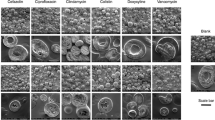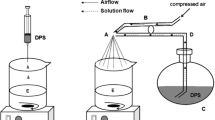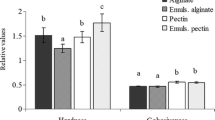Abstract
Polymer controlled release systems are being widely studied as new therapeutic options. The main objectives of these systems are active principle levels control, doses number optimization, secondary effects reduction and patient acceptance. The aim of this study was to design systems for tilmicosin and clarithromycin delivery. To achieve this goal, synthetic and natural polymers, combined with drug saturated suspensions, were evaluated to improve encapsulation efficiencies and release rates of the active principles. Firstly, two systems were studied: poly(lactic-co-glycolic) acid microparticles and biopolymer beads. Depending on the antibiotic used, the microparticles reached encapsulation efficiencies (EE) of 30–90%. Depending on the type of antibiotic and synthesis factors, beads showed EE of 0–40%. The drug release rates were lower for microparticles than those for beads. On the other hand, the inclusion of microparticles into beads was explored as an option for the preparation of biocomposite systems. The release rate of tilmicosin was diminished while that of clarithromycin was not improved. The investigated systems can be an interesting approach for new therapeutic options in the fields of animal and human health.
Graphical abstract











Similar content being viewed by others
Data availability
The authors confirm that the data supporting the findings of this study are available within the article and its supplementary materials.
References
Medlicott NJ, Waldron NA, Foster TP (2004) Sustained release veterinary parenteral products. Adv Drug Deliv Rev 56:1345–1365. https://doi.org/10.1016/j.addr.2004.02.005
Campbell CSJ, Delgado-Charro MB, Camus O, Perera S (2016) Comparison of drug release from poly(lactide-co-glycolide) microspheres and novel fibre formulations. J Biomater Appl 30:1142–1153. https://doi.org/10.1177/0885328215617327
Zhang S, Liu Z, Guo X, Cheng L, Wang Z, Shen J (2008) Simultaneous determination and confirmation of chloramphenicol, thiamphenicol, florfenicol and florfenicol amine in chicken muscle by liquid chromatography-tandem mass spectrometry. J Chromatogr B Analyt Technol Biomed Life Sci 875:399–404. https://doi.org/10.1016/j.jchromb.2008.09.035
Lee BK, Yun YH, Park K (2015) Smart nanoparticles for drug delivery: boundaries and opportunities. Chem Eng Sci 125:158–164. https://doi.org/10.1016/j.ces.2014.06.042
Deb PK, Kokaz SF, Abed SN, Paradkar A, Tekade RK (2019) In: Rakesh K. Tekade (ed) Basic fundamentals of drug delivery. Academic Press
Anderson JM, Shive MS (2012) Biodegradation and biocompatibility of PLA and PLGA microspheres. Adv Drug Deliv Rev 64:72–82. https://doi.org/10.1016/j.addr.2012.09.004
Jain RA (2000) The manufacturing techniques of various drug loaded biodegradable poly(lactide-co-glycolide) (PLGA) devices. Biomaterials 21:2475–2490. https://doi.org/10.1016/S0142-9612(00)00115-0
Busatto C, Pesoa J, Helbling I, Luna J, Estenoz D (2017) Heterogeneous hydrolytic degradation of poly(lactic-co-glycolic acid) microspheres: mathematical modeling. J Appl Polym Sci 134:45464. https://doi.org/10.1002/app.45464
Makadia HK, Siegel SJ (2011) Poly lactic-co-glycolic acid (PLGA) as biodegradable controlled drug delivery carrier. Polymers 3:1377–1397. https://doi.org/10.3390/polym3031377
Mamani PL, Ruiz-Caro R, Veiga MD (2012) Matrix tablets: the effect of hydroxypropyl methylcellulose/anhydrous dibasic calcium phosphate ratio on the release rate of a water-soluble drug through the gastrointestinal tract I. in vitro tests. AAPS PharmSciTech 13:1073–1083. https://doi.org/10.1208/s12249-012-9829-9
Cheptea C, Holban M, Peptu C, Lionte C, Sunel V, Popa M, Desbrieres J (2013) Synthesis and antimicrobial activity of new amidic derivatives of 5-nitroindazol-1-yl acetic acid encapsulated into alginate/pectin particles. Cellul Chem Technol 47:23–29
Islan GA, Castro GR (2014) Tailoring of alginate-gelatin microspheres properties for oral Ciprofloxacin-controlled release against Pseudomonas aeruginosa. Drug Deliv 21:615–626. https://doi.org/10.3109/10717544.2013.870257
Islan GA, Mukherjee A, Castro GR (2015) Development of biopolymer nanocomposite for silver nanoparticles and Ciprofloxacin controlled release. Int J Biol Macromol 72:740–750. https://doi.org/10.1016/j.ijbiomac.2014.09.020
Karp F, Satler FS, Busatto CA, Luna JA, Estenoz DA, Turino LN (2021) Modulating drug release from poly(lactic-co-glycolic) acid microparticles by the addition of alginate and pectin. J Appl Polym Sci 138:50293. https://doi.org/10.1002/app.50293
Zhou K, Wang X, Chen D, Yuan Y, Wang S, Li C, Yan Y, Liu Q, Shao L, Huang L, Yuan Z, Xie S (2019) Enhanced treatment effects of tilmicosin against staphylococcus aureus cow mastitis by self-assembly sodium alginate-nhitosan nanogel. Pharmaceutics 11:524. https://doi.org/10.3390/pharmaceutics11100524
Jacks S, Giguère S, Gronwall RR, Brown MP, Merritt KA (2002) Disposition of oral clarithromycin in foals. J Vet Pharmacol Ther 25:359–362. https://doi.org/10.1046/j.1365-2885.2002.00420.x
Foster SF, Martin P, Davis W, Allan GS, Mitchell DH, Malik R (1999) Chronic pneumonia caused by Mycobacterium thermoresistibile in a cat. J Small Anim Pract 40:433–438. https://doi.org/10.1111/j.1748-5827.1999.tb03118.x
Hansen MP, Thorning S, Aronson JK, Beller EM, Glasziou PP, Hoffmann TC, Del Mar CB (2015) Adverse events in patients taking macrolide antibiotics versus placebo for any indication. Cochrane Database Syst Rev 2015:1–8. https://doi.org/10.1002/14651858.CD011825
Cui Y, Luo L, Li C, Chen P, Chen Y (2018) Long-term macrolide treatment for the prevention of acute exacerbations in COPD: a systematic review and meta-analysis. Int J Chron Obstruct Pulmon Dis 13:3813–3829
Han C, Qi CM, Zhao BK, Cao J, Xie SY, Wang SL, Zhou WZ (2009) Hydrogenated castor oil nanoparticles as carriers for the subcutaneous administration of tilmicosin: in vitro and in vivo studies. J Vet Pharmacol Ther 32:116–123. https://doi.org/10.1111/j.1365-2885.2008.01009.x
Zhang Q, Yang H, Sahito B, Li X, Peng L, Gao X, Ji H, Wang L, Jiang S, Guo D (2020) Nanostructured lipid carriers with exceptional gastrointestinal stability and inhibition of P-gp efflux for improved oral delivery of tilmicosin. Colloids Surfaces B Biointerfaces 187:110649. https://doi.org/10.1016/j.colsurfb.2019.110649
Onyeji CO, Nightingale CH, Nicolau DP, Quintiliani R (1994) Efficacies of liposome-encapsulated clarithromycin and ofloxacin against Mycobacterium avium-M. intracellulare complex in human macrophages. Antimicrob Agents Chemother 38:523–527. https://doi.org/10.1128/AAC.38.3.523
Salem II, Düzgünes N (2003) Efficacies of cyclodextrin-complexed and liposome-encapsulated clarithromycin against Mycobacterium avium complex infection in human macrophages. Int J Pharm 250:403–414. https://doi.org/10.1016/S0378-5173(02)00552-5
Ullah S, Shah MR, Shoaib M, Imran M, Elhissi AMA, Ahmad F, Ali I, Shah SWA (2016) Development of a biocompatible creatinine-based niosomal delivery system for enhanced oral bioavailability of clarithromycin. Drug Deliv 23:3480–3491. https://doi.org/10.1080/10717544.2016.1196768
Pan-In P, Banlunara W, Chaichanawongsaroj N, Wanichwecharungruang S (2014) Ethyl cellulose nanoparticles: clarithomycin encapsulation and eradication of H. pylori. Carbohydr Polym 109:22–27. https://doi.org/10.1016/j.carbpol.2014.03.025
Gattani SG, Savaliya PJ, Belgamwar VS (2010) Floating-mucoadhesive beads of clarithromycin for the treatment of Helicobacter pylori infection. Chem Pharm Bull 58:782–787. https://doi.org/10.1248/cpb.58.782
Sarode S, Sagar G, Kale M, Nimase P, Kulkarni A, Firke S, Firke B, Warke P, Chaudhari M (2010) Preparation and evaluation of floating calcium alginate beads of Clarithromycin. Res J Pharm Dos Forms Technol 2:173–177
Anversa Dimer F, de Souza C-W, Goes A, Cirnski K, Herrmann J, Schmitt V, Pätzold L, Abed N, De Rossi C, Bischoff M, Couvreur P, Müller R, Lehr CM (2020) PLGA nanocapsules improve the delivery of clarithromycin to kill intracellular Staphylococcus aureus and Mycobacterium abscessus. Nanomed Nanotechnol Biol Med 24:102125. https://doi.org/10.1016/j.nano.2019.102125
Alenezi A, Naito Y, Terukina T, Prananingrum W, Jinno Y, Tagami T, Ozeki T, Galli S, Jimbo R (2018) Controlled release of clarithromycin from PLGA microspheres enhances bone regeneration in rabbit calvaria defects. J Biomed Mater Res Part B 106:201–208. https://doi.org/10.1002/jbm.b.33844
Karp F, Turino LN, Helbling IM, Islan GA, Luna JA, Estenoz DA (2021) In situ formed implants based on PLGA and Eudragit blends for novel Florfenicol controlled release formulations. J Pharm Sci 110:1270–1278. https://doi.org/10.1016/j.xphs.2020.11.006
Karp F, Turino LN, Estenoz D, Castro GR, Islan GA (2019) Encapsulation of florfenicol by in situ crystallization into novel alginate-Eudragit RS® blended matrix for pH modulated release. J Drug Deliv Sci Technol 54:101241. https://doi.org/10.1016/j.jddst.2019.101241
Turino LN, Mariano RN, Mengatto LN, Luna JA (2015) In vitro evaluation of suspoemulsions for in situ forming polymeric microspheres and controlled release of progesterone. J Microencapsul 32:538–546. https://doi.org/10.3109/02652048.2015.1065914
Voo WP, Ravindra P, Tey BT, Chan ES (2011) Comparison of alginate and pectin based beads for production of poultry probiotic cells. J Biosci Bioeng 111:294–299. https://doi.org/10.1016/j.jbiosc.2010.11.010
Dyankova SM, Solak AO (2014) Preparation and characterization of composite hydrocolloid films from sodium alginate and high methoxyl pectin. Bulg Chem Commun 46:368–374
Islan GA, De Verti IP, Marchetti SG, Castro GR (2012) Studies of ciprofloxacin encapsulation on alginate/pectin matrixes and its relationship with biodisponibility. Appl Biochem Biotechnol 167:1408–1420
Wischke C, Schwendeman SP (2008) Principles of encapsulating hydrophobic drugs in PLA/PLGA microparticles. Int J Pharm 364:298–327. https://doi.org/10.1016/j.ijpharm.2008.04.042
Derkach SR, Voron’ko NG, Sokolan NI, Kolotova DS, Kuchina YA, (2020) Interactions between gelatin and sodium alginate: UV and FTIR studies. J Dispers Sci Technol 41:690–698. https://doi.org/10.1080/01932691.2019.1611437
Sahito B, Zhang Q, Yang H, Peng L, Gao X, Kashif J, ul Aabdin Z, Jiang S, Wang L, Guo D (2020) Synthesis of tilmicosin nanostructured lipid carriers for improved oral delivery in broilers: physiochemical characterization and cellular permeation. Molecules 25:315. https://doi.org/10.3390/molecules25020315
Avramov Ivić ML, Petrović SD, Vonmoos F, Mijin DZ, Zivković PM, Drljević KM (2008) The electrochemical behavior of commercial clarithromycin and spectroscopic detection of its structural changes. Russ J Electrochem 44:931–936. https://doi.org/10.1134/S1023193508080089
López DF, Osorio O, Checa OE (2019) Propiedades mecánicas de un material de pectina para revestimiento de fibras naturales utilizadas en aplicaciones agrícolas. Inf Tecnológica 30:189–198. https://doi.org/10.4067/S0718-07642019000300189
Karp F, Busatto C, Turino L, Luna J, Estenoz D (2019) PLGA nano- and micro-particles for the controlled release of florfenicol: experimental and theoretical study. J Appl Polym Sci 136:47248. https://doi.org/10.1002/app.47248
Puguan JMC, Yu X, Kim H (2014) Characterization of structure, physico-chemical properties and diffusion behavior of Ca-Alginate gel beads prepared by different gelation methods. J Colloid Interface Sci 432:109–116. https://doi.org/10.1016/j.jcis.2014.06.048
Mordi MN, Pelta MD, Boote V, Morris GA, Barber J (2000) Acid-catalyzed degradation of clarithromycin and erythromycin B: A comparative study using NMR spectroscopy. J Med Chem 43:467–474. https://doi.org/10.1021/jm9904811
Öztürk AA, Yenilmez E, Özarda MG (2019) Clarithromycin-loaded poly (lactic-co-glycolic acid)(PLGA) nanoparticles for oral administration: effect of polymer molecular weight and surface modification with chitosan on formulation, nanoparticle characterization and antibacterial effects. Polymers 11:1632. https://doi.org/10.3390/polym11101632
Chen WF, Pan L, Chen LF, Yu Z, Wang Q, Yan CC (2014) Comparison of EDTA and SDS as potential surface impregnation agents for lead adsorption by activated carbon. Appl Surf Sci 309:38–45. https://doi.org/10.1016/j.apsusc.2014.04.152
Matsubayashi M, Terukina T, Hattori Y, Otsuka M (2018) Preparation of calcium phosphate coated simvastatin-loaded PLGA microspheres dispersed alginate hydrogel beads as a controlled drug delivery carrier. Key Eng Mater 782:201–206. https://doi.org/10.4028/www.scientific.net/KEM.782.201
Kim DH, Martin DC (2006) Sustained release of dexamethasone from hydrophilic matrices using PLGA nanoparticles for neural drug delivery. Biomaterials 27:3031–3037. https://doi.org/10.1016/j.biomaterials.2005.12.021
Acknowledgements
The authors express their gratitude to Consejo Nacional de Investigaciones Científicas y Técnicas (CONICET), Agencia Nacional de Promoción Científica y Tecnológica (ANPCYT, PICT 2018-0202) and Universidad Nacional del Litoral (UNL) of Argentina for the financial support granted to this contribution.
Funding
Universidad Nacional del Litoral,Consejo Nacional de Investigaciones Científicas y Técnicas,Agencia Nacional de Promoción Científica y Tecnológica
Author information
Authors and Affiliations
Corresponding author
Ethics declarations
Conflict of interest
All authors declares that they have no conflict of interest.
Supplementary Information
Below is the link to the electronic supplementary material.
Rights and permissions
Springer Nature or its licensor (e.g. a society or other partner) holds exclusive rights to this article under a publishing agreement with the author(s) or other rightsholder(s); author self-archiving of the accepted manuscript version of this article is solely governed by the terms of such publishing agreement and applicable law.
About this article
Cite this article
Karp, F., Mengatto, L.N., Satler, F.S. et al. Antibiotic delivery based on poly(lactic-co-glycolic) acid and natural polymers: a biocomposite strategy. Iran Polym J 32, 299–312 (2023). https://doi.org/10.1007/s13726-022-01124-x
Received:
Accepted:
Published:
Issue Date:
DOI: https://doi.org/10.1007/s13726-022-01124-x




